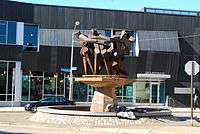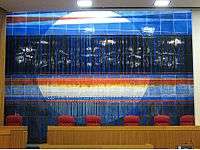Virgil Cantini
| Virgil D. Cantini | |
|---|---|
 Virgil Cantini instructing a class at the University of Pittsburgh during the 1956-57 school year | |
| Born |
February 28, 1919 Italy |
| Died |
May 2, 2009 Pittsburgh |
| Nationality |
Italian-American, U.S. Resident since 1930 |
| Education |
Manhattan College, BFA, Carnegie Mellon University, MFA, University of Pittsburgh Hon. D., Duquesne University |
| Known for | Enamelist, Sculptor |
| Notable work |
"Man" sculpture (1965) "Joy of Life" (1969) |
| Awards |
Time Magazine "Hundred Leaders of Tomorrow" (1953) Guggenheim Fellowship (1957) Pope Paul VI Bishop's Medal (1964) Davinci Medal (1968) |
Virgil David Cantini (1919–2009) was an enamelist,[1] sculptor and educator. He was well known for innovation with enamel and steel[2] and received both local and national recognition for his work, including honorary awards, competitive prizes and commissions,[3] along with a Guggenheim Fellowship in 1957.[4] Cantini long served as a faculty member at the University of Pittsburgh,[5][6] where he helped to create the Department of Studio Arts.[7] A longtime resident of the Oakland neighborhood of Pittsburgh, Pennsylvania, Cantini died on May 2, 2009 at the age of 90.[6] Today, many of his large scale works are on display throughout the city of Pittsburgh.[8]
Life
A native of Italy, Cantini and his family emigrated to Weirton, West Virginia in the 1920s. He initially attended Manhattan College in New York before transferring to Carnegie Institute of Technology (now Carnegie Mellon) where he received a football scholarship and earned All-America status as a quarterback.[6][7] His studies were interrupted by World War II, in which he served the Army making topographical maps and models in North Africa.[6]
Following the war, Cantini received a bachelor’s degree in fine arts in 1946 from Carnegie Tech and married a fellow art student, Lucille Kleber. Cantini went on to earn a master’s in fine arts at the University of Pittsburgh in 1948, and was granted an honorary doctorate in fine arts from Duquesne University in 1982.[7]
Cantini and his wife settled in the Oakland neighborhood of Pittsburgh where they had two daughters, Maria and Lisa,[9] and lived for 60 years. His home on the 200 block of South Craig Street also served as his studio and gallery.[6]
Beginning in 1948, Cantini’s artwork gained national exposure when his enamel “Masquerade” was juried at the 13th National Ceramic Exhibition in Syracuse, New York. In 1953 he was named one of the “Hundred Leaders of Tomorrow” by Time magazine. In 1956, the Pittsburgh Center for the Arts named Cantini the region’s Artist of the Year and he was awarded a Guggenheim Fellowship in 1957.[3] By 1959, Cantini was considered among the most prominent contemporary enamelists, with his work included regularly in New York’s Museum of Contemporary Crafts exhibitions.[7] Cantini was awarded the Pope Paul VI Bishop's Medal in 1964 for "outstanding contribution in the field of liturgical art",[10] and in 1968, he was awarded the Davinci Medal by the Cultural Heritage Foundation of the Italian Sons & Daughters of America.[11]
Cantini taught at the University of Pittsburgh for 38 years, retiring in 1989. He was the first chair of the Department of Studio Arts, which he is credited with establishing.[7] He also served on the University's Athletic Committee in the 1970s.[12] Cantini formerly served as the chair of the Department of Art,[13] and served as Professor of Studio Arts, Emeritus until his death.[14]
Partial list of works



- 24 by 36 foot Mosaic, Teplitz Memorial Moot Courtroom, Barco Law Building, University of Pittsburgh School of Law, representing the artist's conception of the harmony of the law and the rich tapestry of the American legal system[15]
- "Mosaic Tunnel," Glass mosaic (1964), Pedestrian tunnel behind U.S. Steel Tower, beneath Bigelow Boulevard, downtown Pittsburgh.[2]
- "Man," Bronze and Steel sculpture (1965), Parran Hall facade, University of Pittsburgh, Graduate School of Public Health.[16] Cantini designed Man as a sculpture referring to the body, knowledge, and health.[17]
- "Ode to Space," Steel with bronze and glass sculpture (1966), Forbes Avenue at University of Pittsburgh School of Law. Dedicated as a tribute to Chancellor Edward Litchfield, who died in a plane crash in 1968.[17]
- "Joy of Life," Cor-Ten steel sculpture (1969), East Liberty Mall at Penn and Highland Avenues, Pittsburgh. "Joy of Life" has been relocated to a nearby traffic island, at another corner of the East Liberty Presbyterian Church, at South Whitfield Street and Baum Boulevard.[18]
- "Aerial Scape, Skyscape," Porcelain enamel (1970), One Oliver Plaza, Rear Lobby, 210 Sixth Avenue, downtown Pittsburgh. Rear lobby of One Oliver Plaza is to be remodeled in 2009 and the artwork has been given as a gift to the University of Pittsburgh. Will be relocated to Posvar Hall.[2]
- "Science and Mankind" Porcelain enamel mural (1973) in Chevron Science Center at the University of Pittsburgh is said to be his proudest work.[19]
- "Enlightenment and Joy," porcelain enamel mural (1977) entrance to Wesley W. Posvar Hall University of Pittsburgh.[20] The vibrant colors are the result of several layers of paint on each individual tile.[17]
- Large enamel painting framing a crucifix and enamel paintings of the 14 stations of the cross, originally in St. Henry Church in the Arlington neighborhood of Pittsburgh, Pennsylvania, moved to the now failed art museum at the Pope John Paul II Cultural Center in Washington, D.C.[21]
See also
- Parran Hall
- Wesley W. Posvar Hall
- Chevron Science Center
- Barco Law Building
- David Lawrence Hall (University of Pittsburgh)
References
- ↑ Wilson, Winefriede (1965). Christian Art Since the Romantic Movement. Burns & Oates. p. 131.
Virgil Cantini is noted for his enamels in the USA.
- 1 2 3 Office of Public Art (2006). "Pittsburgh Art in Public Places : Downtown Walking Tour". Pittsburgh, PA. pp. 63, 124.
This Pittsburgh artist is known for his innovations with enamel and steel.
- 1 2 Institute of Man (1979). Humanitas. Center for the Study of Human Development of the Institute of Man. p. 133.
VIRGIL CANTINI, contemporary sculptor, artist-teacher and professor of fine arts at the University of Pittsburgh, has received both local and national recognition for his work, including honorary awards, competitive prizes and commissions.
- ↑ John Simon Guggenheim Memorial Foundation (1975). Directory of Fellows, 1925-1974. The Foundation. p. 61.
Cantini, Virgil David. Artist; Professor of Fine Arts, University of Pittsburgh: 1957.
- ↑ Musmanno, Michael Angelo (1965). The story of the Italians in America. Your ancestor series. DoubleDay.
Virgil Cantini of the University of Pittsburgh is a dedicated and accomplished craftsman in painting, sculpture, art metal, and pottery.
- 1 2 3 4 5 Rotstein, Gary (2009-05-05). "Virgil D. Cantini / Acclaimed artist, longtime Pitt professor: Feb. 28, 1919 - May 2, 2009". Pittsburgh Post-Gazette. Retrieved 2009-05-05.
- 1 2 3 4 5 Hart, Peter (2009-05-14). "Obituary: Virgil D. Cantini". University Times. University of Pittsburgh. Retrieved 2009-05-15.
- ↑ "Virgil Cantini - Artist, Art - Virgil D. Cantini". AskART. Retrieved 2007-07-15.
An enamelist sculptor and educator, Virgil Cantini has been a prolific sculptor whose work, often large scale, is throughout the city of Pittsburgh including in the lobbies of office buildings, private homes and in outdoor public places.
- ↑ "Classified Obituaries CANTINI LUCILLE KLEBER". Pittsburgh Post-Gazette. 2008-04-25. Retrieved 2009-05-15.
- ↑ Paull, Barbara (Summer 1971). "Visual Arts: At Home in the University?". Pitt. University of Pittsburgh. 27 (2): 10. Retrieved August 19, 2013.
- ↑ "Biography: Virgil D. Cantini (1920)". Artprice. Retrieved August 19, 2013.
- ↑ "1975 University of Pittsburgh football media guide". University of Pittsburgh Athletics Department. 1975. p. 75. Retrieved 2009-05-15.
- ↑ "Education at Associated Artists of Pittsburgh". Retrieved 2007-07-15.
Virgil Cantini, former chair of the Department of Art at the University of Pittsburgh
- ↑ "Faculty of Arts and Sciences". University of Pittsburgh, Graduate Arts and Sciences. Archived from the original on 2007-06-10. Retrieved 2007-07-15.
VIRGIL D. CANTINI,* Professor of Studio Arts, Emeritus. PhD, Duquesne University
- ↑ "Facilities - About Us - Pitt Law". Retrieved 2007-07-15.
A focus of visual interest is the large (24 by 36 foot) mosaic mounted on the wall behind the judges' bench...a dramatic compound of 126 porcelain-on-steel pieces [that] represents the artist's conception of the harmony of the law and the rich tapestry of the American legal system.
- ↑ "University of Pittsburgh: Graduate School of Public Health: Sculpture". Archived from the original on June 11, 2007. Retrieved 2007-07-15.
Hanging high atop Parran Hall's facade, "Man" symbolizes the human quest for knowledge, with special reference to international research in the health fields.
- 1 2 3 Office of Public Art (2006). "Pittsburgh Art in Public Places - Oakland Walking Tour". Pittsburgh, PA.
Ode to Space...was sited by the University of Pittsburgh as a tribute to Chancellor Edward Litchfield, who died in a plane crash in 1965 [sic].
- ↑ Gaser, Mary Ann (2004). "Meet Me by the Mother's Statue: Sculpture as Landmarks" (pdf). Pittsburgh Teacher's Institute, Chatham University. Retrieved 2012-01-28.
“Virgil Cantini’s Joy of Life is the focal point of the East Liberty Mall. Commissioned by the Urban Redevelopment Authority of Pittsburgh, the fountain was dedicated in 1969.
- ↑ Slattery, Holden (2007-10-25). "Cantini's art beautifies Pitt". The Pitt News. Retrieved 2012-01-28.
Cantini is most proud of his 1973 work, "Science and Mankind," a 40 by 30 foot porcelain enamel mural inside the Chevron Science Center, depicting a man and a woman touching hands, their skeletal and muscular systems exposed.
- ↑ "Office of Public Art Releases Oakland Walking Tour" (PDF). Greater Pittsburgh Arts Council. 2006-11. Retrieved 2007-07-15.
The complete tour takes about 75-120 minutes and includes historic sculptures and buildings such as...Enlightenment and Joy, the 1977 porcelain enamel mural by Virgil Cantini...
Check date values in:|date=(help) - ↑ Ackerman, Jan (2005-08-25). "Arlington church's artwork headed to cultural center in Washington, D.C.". Pittsburgh Post-Gazette.
When St. Henry on Arlington Avenue closes this month, Cantini's 14 enamel paintings of the stations of the cross and the centerpiece enamel painting and crucifix behind the altar at St. Henry will be getting a new life.
External links
Video
- Excerpt 1 from Will Zavala's film Virgil Cantini: The Artist in Public on YouTube
- Excerpt 2 from Will Zavala's film Virgil Cantini: The Artist in Public on YouTube